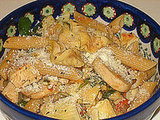vía Serious Eats: New York de Carey Jones
"Fugu, it seemed to me, is the culinary equivalent of the monster in a horror movie. It’s all about the suspense...as soon as you confront it head-on, and take your first bite—you wonder, that was it? And you return to your regularly scheduled (albeit outstanding) Japanese meal."

There may be no more notorious dish in the world than the Japanese fugu, and for good reason. Let’s get the facts straight. Fugu is the Japanese term for the blowfish, a toothy, puffy creature found mainly near shore in temperate or tropical waters. Their skin, ovaries, and liver carry an extremely potent poison called tetrodotoxin, a neurotoxin fatal to humans and other predators at very low doses. And if prepared improperly, yes, it can kill you.
Fugu poisoning isn’t a pleasant way to go. One thousand times more potent than cyanide, even a tiny dose of tetrodoxin acts as a paralytic, effectively disabling muscle tissue. The lips and tongue grow numb first, followed by full-body weakness, seizures, and coma. Death results due to respiratory arrest (since the diaphragm, which enables lung expansion, is paralyzed) or cardiac arrest.
And worse still, tetrodotoxin has no known antidote. While immediate medical treatment can assist breathing and introduce charcoal to bind the poison, its effects cannot be reversed; if the poison has progressed too far, you’re done for.

From the episode, "The Simpsons Go to a Sushi Restaurant" when Homer tries fugu.
So, who’s hungry? As any sushi or Simpsons fan knows, these dangers haven’t stopped the Japanese (and Koreans as well) from preparing and serving fugu for thousands of years—as sushi or sashimi, in stew or fried and served with hot sake. In Japan, the fish is highly regulated: grocery stores must secure a permit to stock fugu, and selling the whole fish is illegal. Sushi chefs must train for years and pass an extraordinarily difficult written and hands-on exam before earning their fugu license. The fish is illegal in the European Union, and is cleaned and stripped of most toxins before shipment to the United States, where only a dozen chefs are licensed to serve it.
 Among these chefs is Toshio Suzuki, owner of the Midtown restaurant Sushi Zen. A sushi master of the highest degree, Suzuki made his mark on America’s conception of Japanese food—he opened one of New York’s first sushi restaurants in 1984, trained “Iron Chef” Morimoto, and invented the California Roll. And fugu appears on his menu for several months in the winter, when the blowfish are in season. What’s more, unlike many other chefs, Sushi Zen offers fugu á la carte. Granted, $13 is a lot to pay for a single piece of sushi—but far less than the hundreds of dollars that an omakase meal elsewhere might set you back.
Among these chefs is Toshio Suzuki, owner of the Midtown restaurant Sushi Zen. A sushi master of the highest degree, Suzuki made his mark on America’s conception of Japanese food—he opened one of New York’s first sushi restaurants in 1984, trained “Iron Chef” Morimoto, and invented the California Roll. And fugu appears on his menu for several months in the winter, when the blowfish are in season. What’s more, unlike many other chefs, Sushi Zen offers fugu á la carte. Granted, $13 is a lot to pay for a single piece of sushi—but far less than the hundreds of dollars that an omakase meal elsewhere might set you back.
The Experience
Walking into Sushi Zen, I felt like I was joining a game of Russian Roulette—my stomach was, quite literally, in knots. But as soon as I sat down in front of Chef Suzuki, my fears were dispelled. This is a man with magic hands.
 He fearlessly shreds a cucumber into uniform matchsticks, using a knife the length of his forearm, in the blink of an eye. He tosses nori over burning charcoal, bare-fingered, to give his hand rolls the perfect crunch. He whips clumps of rice into classically formed sushi nigri within seconds. He scores a piece of squid so carefully that, when he breaks out his blowtorch, each tiny square of flesh curls into a perfect delicate spiral under the heat. This was precision like I had never seen. And if I was to trust my life to anyone’s knife skills, Chef Suzuki’s seemed like the way to go.
He fearlessly shreds a cucumber into uniform matchsticks, using a knife the length of his forearm, in the blink of an eye. He tosses nori over burning charcoal, bare-fingered, to give his hand rolls the perfect crunch. He whips clumps of rice into classically formed sushi nigri within seconds. He scores a piece of squid so carefully that, when he breaks out his blowtorch, each tiny square of flesh curls into a perfect delicate spiral under the heat. This was precision like I had never seen. And if I was to trust my life to anyone’s knife skills, Chef Suzuki’s seemed like the way to go.
The Fugu
 Out it came—first, as part of a stunning appetizer display, with bits of the blowfish’s outermost edible layer suspended in a soy-colored gelée. The slightly tough skin added a welcome bit of texture to the otherwise soft jelly, with a salty, almost smoky flavor.
Out it came—first, as part of a stunning appetizer display, with bits of the blowfish’s outermost edible layer suspended in a soy-colored gelée. The slightly tough skin added a welcome bit of texture to the otherwise soft jelly, with a salty, almost smoky flavor.
I swallowed. No tingling, no numbness. So far, so good.
Then came the fugu sushi, with a delicate swab of radish and pepper with shredded scallions perched atop. Chopsticks ready; round two. I took a bite.
The fugu was tough, unusually tough, halfway between a white fish and a squid. And with a mild fishy taste, it lacked almost any flavor of its own. The radish and scallion, however, brightened the bite right up. Chef Suzuki leaves most fish unadorned, but for a dab of wasabi and brush of soy sauce; the fugu, however, needed a little something extra.

As I swallowed and reached for my glass, a faint tingling crept across my lips. A tiny hint of lingering toxin? A psychosomatic trace of fear? I didn’t know. But I managed to walk out of the restaurant an hour later, and that was enough for me.
Fugu, it seemed to me, is the culinary equivalent of the monster in a horror movie. It’s all about the suspense. As long as it remains off-screen, it’s terrifying. But as soon as you confront it head-on, and take your first bite—you wonder, that was it? And you return to your regularly scheduled (albeit outstanding) Japanese meal.

In the end, the terror of eating fugu was dwarfed by Chef Suzuki’s other creations: tempura-fried figs, delicately steamed Japanese pumpkin, fluffy rice-stuffed tamagoyaki, buttery bluefin, thrice-cooked skinless unagi, fluke with monkfish liver—it was these that spoke to his genius and artistry, rather than his ability to serve blowfish and have his patrons escape alive. Although, in truth, that’s the ability I appreciated most.
Fugu is available for a few more weeks at Sushi Zen; if your heart is set on a brush with death, call ahead to make sure they have it fresh.














 Among these chefs is Toshio Suzuki, owner of the Midtown restaurant Sushi Zen. A sushi master of the highest degree, Suzuki made his mark on America’s conception of Japanese food—he opened one of New York’s first sushi restaurants in 1984, trained “Iron Chef” Morimoto, and invented the California Roll. And fugu appears on his menu for several months in the winter, when the blowfish are in season. What’s more, unlike many other chefs, Sushi Zen offers fugu á la carte. Granted, $13 is a lot to pay for a single piece of sushi—but far less than the hundreds of dollars that an omakase meal elsewhere might set you back.
Among these chefs is Toshio Suzuki, owner of the Midtown restaurant Sushi Zen. A sushi master of the highest degree, Suzuki made his mark on America’s conception of Japanese food—he opened one of New York’s first sushi restaurants in 1984, trained “Iron Chef” Morimoto, and invented the California Roll. And fugu appears on his menu for several months in the winter, when the blowfish are in season. What’s more, unlike many other chefs, Sushi Zen offers fugu á la carte. Granted, $13 is a lot to pay for a single piece of sushi—but far less than the hundreds of dollars that an omakase meal elsewhere might set you back.  He fearlessly shreds a cucumber into uniform matchsticks, using a knife the length of his forearm, in the blink of an eye. He tosses nori over burning charcoal, bare-fingered, to give his hand rolls the perfect crunch. He whips clumps of rice into classically formed sushi nigri within seconds. He scores a piece of squid so carefully that, when he breaks out his blowtorch, each tiny square of flesh curls into a perfect delicate spiral under the heat. This was precision like I had never seen. And if I was to trust my life to anyone’s knife skills, Chef Suzuki’s seemed like the way to go.
He fearlessly shreds a cucumber into uniform matchsticks, using a knife the length of his forearm, in the blink of an eye. He tosses nori over burning charcoal, bare-fingered, to give his hand rolls the perfect crunch. He whips clumps of rice into classically formed sushi nigri within seconds. He scores a piece of squid so carefully that, when he breaks out his blowtorch, each tiny square of flesh curls into a perfect delicate spiral under the heat. This was precision like I had never seen. And if I was to trust my life to anyone’s knife skills, Chef Suzuki’s seemed like the way to go.  Out it came—first, as part of a stunning appetizer display, with bits of the blowfish’s outermost edible layer suspended in a soy-colored gelée. The slightly tough skin added a welcome bit of texture to the otherwise soft jelly, with a salty, almost smoky flavor.
Out it came—first, as part of a stunning appetizer display, with bits of the blowfish’s outermost edible layer suspended in a soy-colored gelée. The slightly tough skin added a welcome bit of texture to the otherwise soft jelly, with a salty, almost smoky flavor. 

















